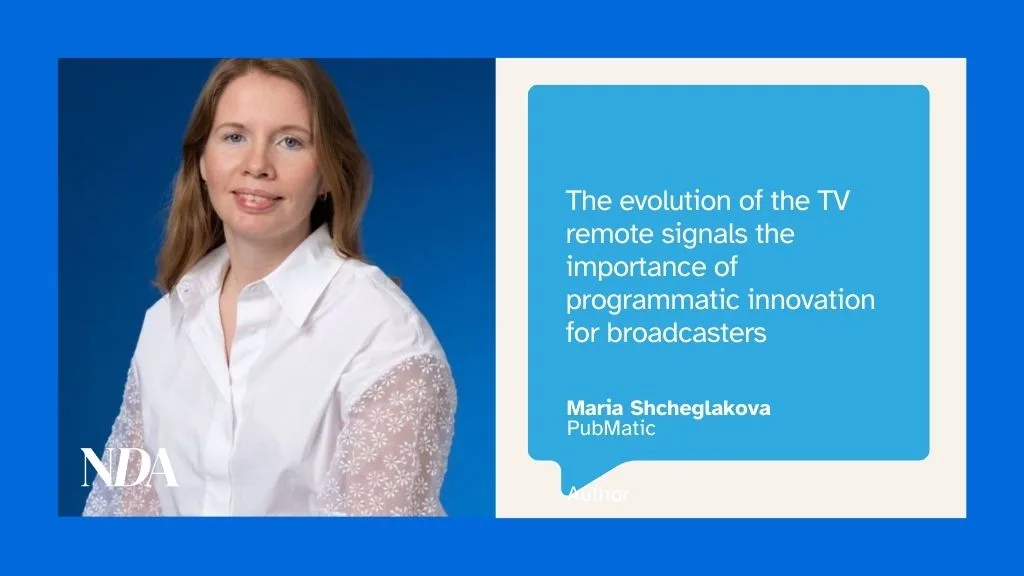By Maria Shcheglakova, EMEA Marketing Director, PubMatic
Working in digital marketing, I’ve observed the rise of Connected TV (CTV) with a keen interest. The explosion of content platforms and the corresponding decline in linear TV viewing, the rise of new data providers and ID solutions, and the creative innovations have been fascinating to watch. However, recently, while at home with my young son, I observed another change that, although obvious, had gone largely unnoticed.
When my son wants to watch TV, he presses one of four buttons on the remote control and heads straight to the app that streams his cartoon of choice. He doesn’t go to the home screen, he doesn’t browse through various content options. His entire user experience bypasses broadcasters, it doesn’t involve scrolling through a list of different apps. With one press of a button, he gets the content he wants, no discovery, no consideration, no fuss.
TV remotes are the gatekeepers of user experience
There is one thing, and one thing alone, that makes this quick, seamless access to content possible – the TV remote. The simple fact that our TV remote has buttons that open specific apps negates the need for users to choose where they want to get their video content through a menu. This is a stark contrast to the remote controls and TV programming that I grew up with.
Today’s app-centric remote controls with dedicated buttons for some of the most popular streaming apps like Netflix, Amazon Prime, Disney and more have had a profound impact on our decision-making process, as the choice of content begins with these app buttons rather than traditional TV channels. These app-centric remotes also make it extremely easy for viewers to navigate away from content if the user experience doesn’t live up to their expectations. But these deals are expensive and local broadcasters often simply can’t afford to compete with the streaming giants meaning that they need alternative strategies to compete for viewers’ attention.
In this new era where the remote control has become a commercial battlefield, broadcasters need new strategies to safeguard their market share and continue to capture and maintain the attention of viewers – especially from younger audiences who do not follow traditional content discovery paths.
With more consumers bypassing traditional broadcaster content discovery, it’s critical broadcasters have strategies in place to maximise the value of each user that does consume their content. This is where programmatic technology can help because by enabling broadcasters to better match both users’ preferences for content consumption and ad experiences with media buyers’ expectations. It can also help facilitate more precise audience targeting, effective supply path optimisation (SPO), and real-time campaign optimisation.
How can broadcasters get maximum value from programmatic technology?
Many broadcasters already have a programmatic strategy in place. However, with competition for content discovery heating up, it is vital to remain agile and adaptable embracing new capabilities as they come to market. Here are some of the key benefits of programmatic technology for broadcasters looking to maximise their value in 2024 and compete effectively against the platforms that can afford to place their branding and access to their content directly within the remote control.
Better audience targeting: Programmatic technology enables broadcasters to segment their audiences by demographics, behaviours, and interests. This facilitates a more personalised advertising experience which increases attention and engagement benefitting broadcasters, advertisers and consumers. In addition, advertisers can layer first- and third-party data to further increase personalisation and relevance. For example: using first-party data advertisers can target, or exclude, existing customers, or third-party data can be used to target households that are similar to a brand’s most valuable first-party users.
For smaller brands, the additional audience targeting capabilities that come with programmatic can make TV advertising a cost-effective option. By opting to target only a relevant portion of a broadcaster’s vast audience and thus reducing entry costs, small brands can see themselves on the big screen much sooner in their development opening up a new pool of potential buyers for broadcasters.
Cost-effective ad sales: Automating a portion of the ad sales process is highly cost-efficient for broadcasters. By providing buyers with a programmatic technology-based route to market, broadcasters can ensure optimal resource allocation and improved overall return on investment (ROI).
Real-Time Optimisation: Programmatic TV enables real-time optimisation of ad placements based on viewer behaviour and preferences, ensuring that content remains compelling and engaging. This helps broadcasters to maintain viewers’ attention hour after hour which is vital in today’s highly competitive total video landscape.
Creative expansion and compliance: Programmatic solutions enable broadcasters to offer a wider array of ad formats with compliance checks and procedures built into the creative process. This not only makes advertising more engaging and attracts better audience attention but reduces the impact on internal resources when it comes to managing creative.
Data-Driven Insights: By leveraging data analytics, broadcasters gain valuable insights into viewer behaviour, enabling them to make informed decisions about content creation, scheduling, and advertising strategies. Programmatic also provides broadcasters with additional data points that are not generated through upfront/guaranteed campaigns. These additional insights can help with yield management and inform future deal structures.
For advertisers, the additional data gleaned through programmatic campaigns enables them to make better, more informed decisions about ad placements and achieve higher performance and conversion rates. This helps advertisers pinpoint areas of inefficiency and modify their advertising strategies accordingly, ensuring they get the most value out of their ad spend which in turn fosters more long-term, strategic partnerships.
Diversified Monetisation Opportunities: Programmatic advertising is often the first route to market for new avenues for monetisation. By adopting an agile programmatic approach, broadcasters can capitalise on the evolving media landscape and tap into the latest non-linear trends quickly.
Advanced Yield Management: Running auction-based programmatic campaigns help broadcasters understand what buyers are prepared to pay for their inventory. This can help when looking at how to price inventory, particularly when demand is high and/or broadcasters are approaching maximum capacity.
Adaptability is key to future success
While conducting research for this article – which I hope you have found useful – I found an article about the origins of the TV remote control, which was invented in the 1950s. I was surprised to learn that the inventor’s motivation was not laziness (as I had previously assumed) but a desire to mute ads! I find it interesting that not only has TV advertising come a long way since then – hopefully resulting in far fewer people muting ads – but that the TV remote has (somewhat ironically) become a portal to a plethora of ad-funded TV content that those living in the 1950s could not have dreamed of.
The evolution of the TV remote has mirrored the dynamic shifts in the way we consume content. From the humble beginnings of a TV with no remote and a nine-digit dial for each available channel, we’ve witnessed a remarkable transformation in the interface that dictates our viewing experience.
As linear TV faces challenges with declining viewership and increased competition through remote control branding/content access, programmatic TV emerges as a strategic imperative for broadcasters looking to adapt to changing consumer habits and deliver a more personalised and engaging viewing experience.
When you combine all the core things that have made television so powerful with the sophistication of programmatic what emerges is a highly compelling argument for brands to invest their money with broadcasters. You’re going to reach a lot of people, and you can create a harmonious consumer experience across all channels including creative personalisation and frequency capping all while optimising towards your business objectives.









